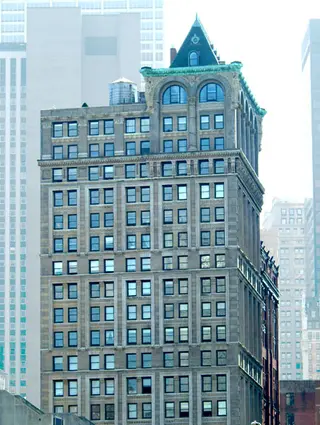 Carter Horsley
Carter HorsleyDec 23, 2011
Carter's Review
This imposing 23-story building is directly across Spruce Street from the entrance to Pace University and it overlooks both City Hall and the Brooklyn Bridge.
Erected in 1895 as one of the city's tallest and largest towers, it was designed by Robert Henderson Robertson and was designated an official individual New York City landmark in 1999. It is one of the earliest steel skeletal frame skyscrapers in the city.
It is clad in rusticated gray Westerly granite, gray Haverstraw Roman brick, and buff-colored terra cotta. It has a u-shaped plan with an exterior light court on the south side.
Its design is a combination of Romanesque and Renaissance Revival styles. Its two main façades are divided into six horizontal sections and a three-story arcade, open at the top story and with winged caryatids at the upper corners, tops the western half of the building and a three-story hipped roof tower rises through the arcade creating an unusual top.
The American Tract Society was founded in 1825 and became one of the nation's largest publishers of religious literature before the Civil War. This building was originally conceived as a speculative building but the society moved out of it in 1914 when it lost the building through foreclosure.
From 1914 to 1919 the lower part of the building was leased to the New York Sun. At the end of the 19th Century, this neighborhood was the center of the city's newspaper publishing industry.
The building is notable for its deeply inset windows, the superb lions' heads on its stringcourses and its fine monumentality.
It was converted to a condominium in 2003 with 125 apartments and has a doorman and a concierge, but no balconies and no sidewalk landscaping. It has a two-step-up entrance.
A semicircular lobby with its elevator cars arranged along the arc had marble decor and a coffered ceiling, as well as a manually operated elevator, one of the last of its kind in NYC, but was replaced with a rectilinear lobby designed by Shamir Shah when the building was converted.
The architect, Robert Henderson Robertson (1849-1919), was a prolific designer on residential, commercial, and institutional buildings in the late nineteenth and early twentieth centuries. Early in his career, Robertson worked with architect William Potter, but by 1881 he had established his own office. Much of his early work reflects the influence of Henry Hobson Richardson's Romanesque-revival designs, evident, for example, at the Lincoln Building (1889-90) at 1 Union Square West on the northwest corner at 14th Street, a transitional skyscraper, incorporating an elevator and iron construction, but lacking a steel-skeleton frame. Among his other extant skyscrapers are the 30-story, twin-towered, 41 Park Row Building (1899), once the world's tallest office building.
This building has four apartments per floor and a duplex penthouse.
The building has a common roof deck, and a fitness center, and an exposed rooftop water tank.

- Condo built in 1894
- Converted in 2002
- 1 apartment currently for sale ($2.9M)
- Located in Financial District
- 125 total apartments 125 total apartments
- 10 recent sales ($820K to $2.9M)
- Doorman
- Pets Allowed
 6sqft delivers the latest on real estate, architecture, and design, straight from New York City.
6sqft delivers the latest on real estate, architecture, and design, straight from New York City.
